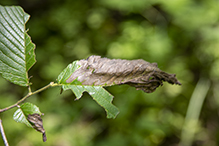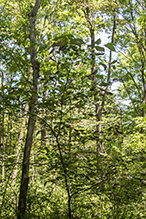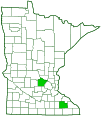Elm leafminer
(Fenusa ulmi)
Conservation • Description • Habitat • Ecology • Distribution • Taxonomy
Conservation Status |
|||
| IUCN Red List | not listed |
||
| NatureServe | not listed |
||
| Minnesota | not listed |
||
Description |
Elm leafminer is a very small common sawfly. It is native to eastern Europe and Scandinavia. It was brought to North America most likely on imported elms. It now occurs in the United States from New England to the upper Midwest, in the Pacific Northwest, and in southeast Canada. Based on the scarcity of reports, it is still relatively uncommon in Minnesota. Adults are small, about ⅛″ (4 mm) long, and dark colored. More detailed information about the adult is not available. Due to the small size of the adult, elm leafminer is most often identified by the damage the larva causes to its host plant. Mines are seen from mid-May to early June on American elm and slippery elm. The larva feeds between the upper and lower surfaces of the leaf. It creates a serpentine mine at first. That soon develops into a small blotch between two lateral veins, later into a large blotch on one side if the midrib. The mines are clear and the flattened, whitish-green or yellowish-white larva can be seen when viewing the upper side of the leaf. The frass can also be seen within the mine. It appears as long, connected chains at first, later as loose grains. The infected part of the leaf turns brown and eventually falls off. A heavy infestation may cause the entire tree to defoliate, but the infected tree flushes again and survives. |
Size |
Total length: about ⅛″ (4 mm) |
Similar Species |
Habitat |
Elms |
Ecology |
Season |
One generation per year: Mid-March to mid-April |
Behavior |
|
Life Cycle |
Adults emerge from mid-March to mid-April, depending on the temperature and coinciding with opening of elm leaf buds. The adults are all female. Males are rare in Europe and have not been found in North America. Eggs develop into embryos without first being fertilized by sperm (parthenogenesis). The female begins laying eggs immediately after emerging. She creates a slit in the upper surface of a leaf into which she deposits a single egg. At first, eggs are laid near leaf veins. Later they are placed anywhere on the leaf. The eggs hatch in about ten days. Each larva passes through five stages (instars), then drops to the ground and burrows into the soil. It then forms a thin, papery cocoon, where it remains in the pupal stage through summer, fall, and winter. |
Larva Food |
Leaves of elm trees, including American elm and slippery elm |
Adult Food |
|
Distribution |
||
|
Sources |
|
| 8/31/2025 | ||
Occurrence |
||
|
||
Taxonomy |
|
Order |
Hymenoptera (Ants, Bees, Wasps, and Sawflies) |
Suborder |
Symphyta (Sawflies, Horntails, and Wood Wasps) |
Superfamily |
Tenthredinoidea (Typical Sawflies) |
Family |
|
Subfamily |
Heterarthrinae |
Tribe |
Fenusini |
Genus |
Fenusa |
Subordinate Taxa |
|
|
|
Synonyms |
|
Caliosysphinga ulmi Fenusa intermedia Kaliofenusa ulmi Messa alsia |
|
Common Names |
|
elm leaf miner elm leafminer |
|
Glossary
Instar
The developmental stage of arthropods between each molt; in insects, the developmental stage of the larvae or nymph.
Visitor Photos |
Share your photo of this insect. |
||
This button not working for you? |
||
|
||
MinnesotaSeasons.com Photos |
 |
 |

Slideshows |
Fenusa ulmi |

Visitor Videos |
Share your video of this insect. |
||
This button not working for you? |
||
|
Other Videos |
Elm Leaf Miner Clip |
About
Oct 31, 2014 |

Visitor Sightings |
Report a sighting of this insect. |
||
This button not working for you? |
||
MinnesotaSeasons.com Sightings |

|
Created: 11/9/2019 Last Updated: © MinnesotaSeasons.com. All rights reserved. |
